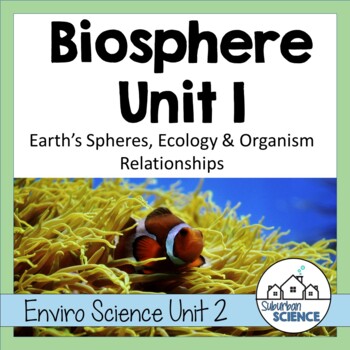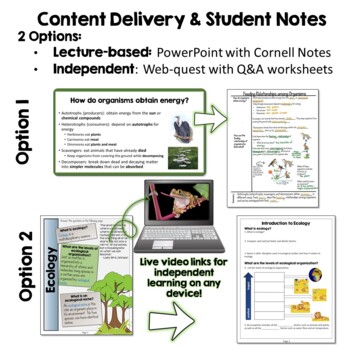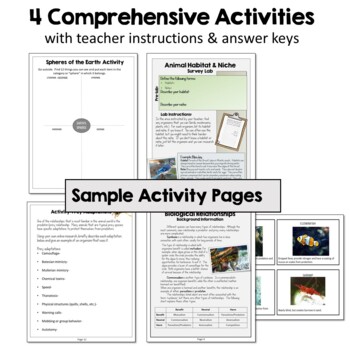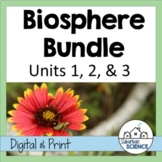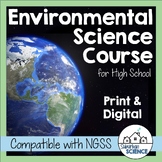Environmental Science Unit: Ecology, Food Webs, Symbiosis, Earth's Spheres
- Zip
What educators are saying
Also included in
- This bundle contains a month's worth of lessons, labs, and field activities and is perfect for an introduction to a high school environmental science course. The notes and projects are designed to facilitate independent learning and are ideal for sub plans or simply to encourage self-instruction ofPrice $50.00Original Price $59.00Save $9.00
- These environmental lesson plans will help your students to take charge of their learning! This comprehensive course is interactive, hands-on, and student-centered! Students learn about major environmental issues in modern society through detailed lessons and activities. Units cover the four sphePrice $250.00Original Price $276.00Save $26.00
Description
This bundle of lessons, labs, and field activities will introduce your high school students to the basics of ecology, food chains and food webs, and symbiotic relationships.
All student pages come in both PRINT and DIGITAL for efficient use in class or through distance learning.
➤What's included?
-10 Teacher Planning Pages (standards document, editable daily pacing guide, differentiation ideas for student interest, ability, and learning environment)
-1 PowerPoint (27 editable slides- highly visual and fully animated)
-4 pages of Cornell Notes (both fill-in-the-blank and editable versions included)
-3 web-quests with corresponding student pages for independent learning
-3 pages of my popular Doodle Notes(TM) and a guide to using them in your classroom
-4 Activities:
- Spheres of the Earth outdoor activity
- Animal Habitat and Niche Survey
- Biological Relationships Symbiosis Activity
- Prey Adaptations Research Activity
-3 Extension Pages:
- 2 Digging Deeper extensions for increased depth of knowledge & critical thinking skills (Ecological Niches & Animal Relationships)
- 1 Data Analysis extension for math practice (Energy Pyramid)
-2 concept maps to summarize content (guided and blank provided)
-1 online quiz through Google Forms for automatic grading
-20 editable task cards for a quick and easy unit review
-Editable unit test with multiple-choice and short answer questions (in both honors and regular versions)
-Supplementary Resource Ideas: links and videos for additional explanation or exploration
-Answer keys for all student pages
➤What topics are included in this unit?
Spheres of the Earth
- Hydrosphere, geosphere, atmosphere, biosphere, cryosphere
- Interactions between spheres
Basics of Ecology
- Biotic v. abiotic factors
- Organization of living things (organism, population, community, ecosystem, biome, biosphere)
- Habitat v. niche
Organism Relationships
- Herbivores, carnivores, omnivores, producers, scavengers, decomposers
- Food chains v. food webs
- Energy pyramid and trophic levels
- Conservation of energy and First Law of Thermodynamics
- Symbiotic relationships (mutualism, commensalism, parasitism, predation)
- Prey adaptations
The unit is aligned to NGSS and many state standards. If you’d like to know whether your state standards are covered, you can send me an email at support@suburbanscience.com.
NGSS addressed in this unit: HS-LS1-5, HS-LS1-6, HS-LS2-1, HS-LS2-4, HS-LS2-8, HS-ESS2-2. Additional details on standards are included in the teacher planning pages of this course.
________________________________________________________________________
*For more details about the specific topics and items included, please see my PREVIEW.*
➤Where can I find other Environmental Science lessons?
Intro to Environmental Science
Biosphere Unit 1: Ecology, Food webs, and Symbiosis
Biosphere Unit 2: Species and Population Ecology
Biosphere Unit 3: World Biomes, Ecological Succession, and Biodiversity
Atmosphere: Weather, Wind, and Biogeochemical Cycles
Geosphere Unit 1: Plate Tectonics and Landforms
Geosphere Unit 2: Minerals, Mining, and Soil
Geosphere Unit 3: Fossil Fuels and Renewable Energy
Hydrosphere Unit 1: Surface Water, Groundwater, and the Water Cycle
Hydrosphere Unit 2: Marine Biomes and Water Pollution
Or get the Full Environmental Science Curriculum which includes all these units!
➤What curriculum could I use with this lesson?
This lesson is ideally geared toward high school students and would work well with a general-level Environmental Science or Biology textbook. It addresses the following topics in AP Environmental Science (APES):
- 1.1 Introduction to Ecosystems
- 1.9 Trophic Levels
- 1.10 Energy Flow and the 10% Rule
- 1.11 Food Chains and Food Webs
- 2.4 Ecological Tolerance
- 2.6 Adaptations
➤Can I edit these resources to fit my needs?
Some of the files in this unit are editable. The text on the PowerPoints, Cornell Notes, and task cards is all editable so you can adjust the level of content and wording. The pacing guide, printable unit tests, and online quizzes through Google Forms™ are all fully editable. Web-quests, activities, extension pages, and any images included in this unit are in non-editable PDF formats to protect my intellectual property rights and those of the illustrators whose images I’ve purchased for use in this resource.
______________________________________________________________________________
⭐For updates about sales and new products, please follow my store: My TpT Store
You can also
⭐Subscribe to my newsletter for freebies and teaching tips
⭐Follow me on Instagram
⭐Check out my Facebook page
⭐Follow me on Pinterest
I value your feedback. Please rate this product. If you have any issues or questions about this product, please feel free to ask a question in my store or write to me at support@suburbanscience.com.

